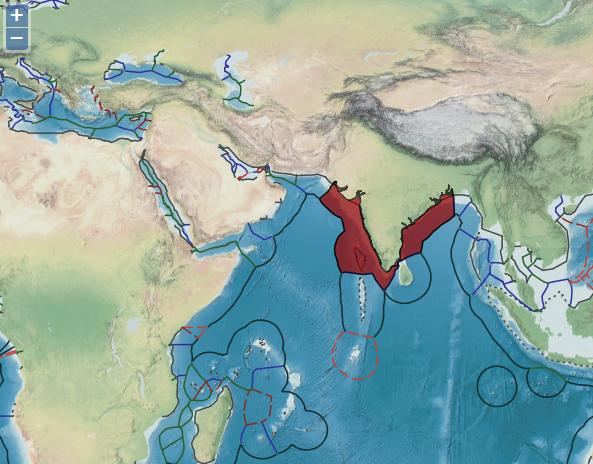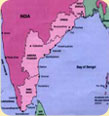
| Year of Independence | 1947 |
| Location | South Asia, bordering the Arabian Sea and the Bay of Bengal, between Myanmar and Pakistan |
| Surface area (2014) (sq. km.) | 3,287,263 |
| Climate | Varies from tropical monsoon in south to temperate in north |
| Capital City | New Delhi |
| Administrative Set up | Federal Parliamentary Republic |
| Administrative Units | 29 States and 7 Union Territories |
| Currency | Indian Rupee |
| Population growth rate (2010-15) (%) | 1.3 |
| Population (projected, 000) (2016) | 1,326,802 |
| Population density (per sq. km) (2016) | 446.3 |
| Sex ratio (total) (2016) | 1.08 |
| Total dependency ratio (2015) | 52.4 |
| Total adult literacy rate (%) 2008-2012* | 62.8 |
| Life expectancy at birth (years) 2012 | 66.21 |
| GDP: Gross Domestic Product (million current US$) (2014) | 2,054,941 |
| GDP growth rate (annual %, const. 2005 prices) (2014) | 7.3 |
| GDP per capita (current US$) (2014) | 1,581.51 |
| Economy: Agriculture (% of GVA) (2014) | 17.0 |
| Employment: Agriculture (% of employed) (2010) | 33.7 |
| Unemployment (% of labour force) (2014) | 3.5 |
| Labour force participation (female/male pop. %) (2014) | 26.7/79.1 |
| CPI: Consumer Price Index (2000=100) (2014) | 256 |
| Agricultural production index (2004-2006=100) (2014) | 140 |
| Exports (million US$) (2015) | 264,381 |
| Railways (km)(2014) | 68,525 |
| Roadways (km) (2014) | 4,699,024 |
| Mobile cellular (subscriptions per 100 inhabitants) (2015) | 78.8 |
| Internet users (pop. %) (2015) | 26 |
| Human Development Index (2014) | 0.624 (131st) |
| Economic Freedom Index (2017) | 62.60 |
| Environmental Performance Index (2018) | 30.57 (Rank 177) |
Profile of Marine Fisheries of India
| Aspects | Profile |
| 1.Environment and major fish stocks | Tropical multi-species, multi-gear fisheries, spread over an EEZ of 2.02 million km2 and coastline of 8,118 km length. However, fishing effort is concentrated largely within inshore coastal areas (<100 meters of depth). Seasonal monsoons and currents determine the productivity of the fisheries. The major fisheries focus is on small pelagics (e.g. sardines), demersals (e.g. sharks) and crustaceans (e.g. penaeid shrimps). |
| 2.Production and landings | Marine fisheries landings are 3.58 million tonnes (2015-16) with an average annual growth rate of 2.46% during the last 10 years. Total fish landing composition includes sardines (oil sardine + lesser sardines) (14.8%), Indian mackerel (6.8%), shrimps (5.7%) and ribbonfish (%) as major components. Total production from inland capture and aquaculture is 7.21 million tonnes. |
| 3.Fishing craft, technology & infrastructure | India’s marine fisheries are dominated by small-scale operations (vessels < 15 m). The marine fishing fleet comprises three categories: 72,749 mechanised (with wheel house and in-board engine), 73,410 motorised (out-board motor) and 52,982 non-motorised boats. Mechanised, motorised and non-motorised boats contributed 75%, 22% and 3% to the total landings, respectively. Among the fleet, trawlers contributed the largest share of the landings (55% of total marine landings). Fishing is carried out from 9 coastal States, 2 Union Territories (UT) in the mainland and 2 Islands. There are 1,537 landings centres, including fishing harbours. The landing centres, in general, are poorly maintained. There are a total of 620 pre-processing units; 465 fish processing plants, and 479 cold storages. |
| 4.Post-harvest, trade and markets | Per capita annual consumption of fish is about 3 kg and it provides 2.02% of total protein intake. Presently, about 74 to 76% of the fish are consumed fresh; 12% frozen and 4% cured. |
| 5.Economic aspects | Fisheries (including capture fisheries and aquaculture) contributed 0.83% of the GDP in 2012-13 (at 2004-05 prices). The gross revenue of marine fish landings was estimated as INR 40,100 crores (USD 6,169 million) at the landing centre and as INR 65,180 crores (USD 10,277 million) at retail market. India exports frozen shrimp and other fish and fisheries products to a number of EU member-countries, USA, East Asia including China, Japan and other countries. Total exports were 1.05 million tonnes (from capture fisheries and aquaculture) valued at INR 304,208.3 million (USD 4,680 million). Compared to the previous year, seafood exports recorded a growth of 6.86 % in quantity, 10.69% in rupee value and 10.05 % growth in USD earnings. |
| 6.People, social aspects & human capacity | There are about 1,002,543 active fishermen and 625,663 people in related activities in the marine fisheries sector. There are 864,550 fisher households distributed in 3,288 fishing villages in mainland India (2010). The average family size is 4.6 persons. Nearly 61% of marine fisher families are Below the National Poverty Line. About 57.8% of the fishers have at least primary level of education. Nearly 82% of people engaged in fish marketing are women. Fishing communities in India, are diverse containing different religions and castes. These communities have their distinct social, cultural, governance structures and traditional practices, depending upon the location. Many fishers are members of formal co-operatives (functions include purchase and supply of fishing inputs; accessing government schemes, etc.). |
| 7.Organisations | Department of Animal Husbandry, Dairying & Fisheries (DAHD&F) under the Ministry of Agriculture and Farmers Welfare is responsible for fisheries management, trade and development. The Fisheries Division within the DAHD&F implements and monitors the central sector and centrally sponsored schemes delivered through the State/UT governments. The Division is the focal point for fisheries policy, strategy, management and development. The DAHD&F is responsible for fisheries management in the Indian EEZ outside of the 12 nautical mile territorial boundary. The Department of Fisheries in each of the 9 coastal States/UTs is responsible for fisheries management within 12 nautical miles (22 km from coastline). |
| 8.Institutions and law | Fisheries development and planning until recently was undertaken through the Five-Year Plans formulated by the government since 1951. The initial Five-Year Plans, starting from the 1950s, focused more on the ‘development’ of the sector, and on increasing production, while it was only in the Ninth and Tenth Five-Year Plan period that the need for conservation and management was explicitly recognized. The central legal frameworks are Indian Fisheries Act, 1897; The Territorial Waters, Continental Shelf, Exclusive Economic Zone and other Maritime Zones Act, 1976; Maritime Zones of India (Regulation of Fishing by Foreign Vessels) Act, 1981 and the Maritime Zones of India (Regulation of Fishing by Foreign Vessels) Rules, 1982; Comprehensive Marine Fishing Policy, 2004; Coastal Regulation Zone Notification, January 2011; Corrigendum to Coastal Regulation Zone Notification, April 1st 2011; Wetlands (Conservation and Management) Rules, 2010. Besides these, there are other important legislation relevant for fisheries and fishing communities, such as Coastal Aquaculture Authority Act, 2005; The Biological Diversity Act, 2002; The Wildlife (Protection) Act, 1972 (as amended 2002 and 2006); Environment (Protection) Act, 1986; Marine Products Export Development Authority Act, 1972; Merchant Shipping Act, 1958; Fisheries within the 12-mile territorial limits are managed under the Marine Fishing Regulation Acts (MFRA) of the coastal States of India. |
| 9.Fisheries Policy & Management | At present, important management measures adopted include: prohibition of destructive fishing gear, regulations on mesh size, establishment of closed seasons and areas, demarcations of zones for no-trawling, besides other measures such as use of turtle excluder devices, and designated no-fishing areas. Besides these, several conservation measures have been implemented by the Ministry of Environment, Forests and Climate Change towards conservation and preventing trade on endangered species such as sea turtles, sea cucumbers, seahorses, marine mammals and several species of molluscs, and protection of critical habitats such as coral reefs, mangroves and nesting grounds of turtles, by designating protected areas (such as national parks and sanctuaries). However, there is a scope to improve implementation. India is also a signatory to FAO’s Code of Conduct for Responsible Fisheries (CCRF) framed in 1995. But it is yet to implement its national CCRF with robust legal and institutional framework. In response to the need to strengthen the institutional framework, a new National Policy on Marine Fisheries, 2017 (NPMF, 2017) has been formulated. The Policy is based on seven pillars: sustainable development, socio-economic upliftment of fishers, principle of subsidiarity, partnership, inter- generational equity, gender justice and precautionary approach. The Government proposes to address issues and take advantage of opportunities related to fisheries management, Monitoring, Control and Surveillance, collection of fisheries data and analysis, island fisheries, mariculture, post-harvest and processing, trade, marine environment and pollution, climate change, fisher welfare, social security and institutional credits, gender equity, additional/alternate livelihoods, blue growth initiative, international agreements, regional cooperation, and institutional aspects. |
| 10. Challenges and issues | While marine fisheries production appears to be stable overall, some studies show that a number of fish stocks are in decline despite the application of a range of management measures. An effective management regime with strengthened implementation is required. Other major challenges include optimizing fishing effort; curbing pollution; protecting coastal areas from adverse impact of urbanization; improvements in infrastructure facilities (e.g. harbours); curbing use of destructive fishing gear; social security net to poor small-scale fishers; alternative livelihoods; and dealing with climate change. |
 |
|
| CountryMap |
 CCRF Tamil |
 CCRF Tamil |
 CCRF Bengali |
 CCRF Oriya |
 CCRF Telugu |
 CCRF Marathi |
 CCRF Gujarati |
 CCRF Hindi |





